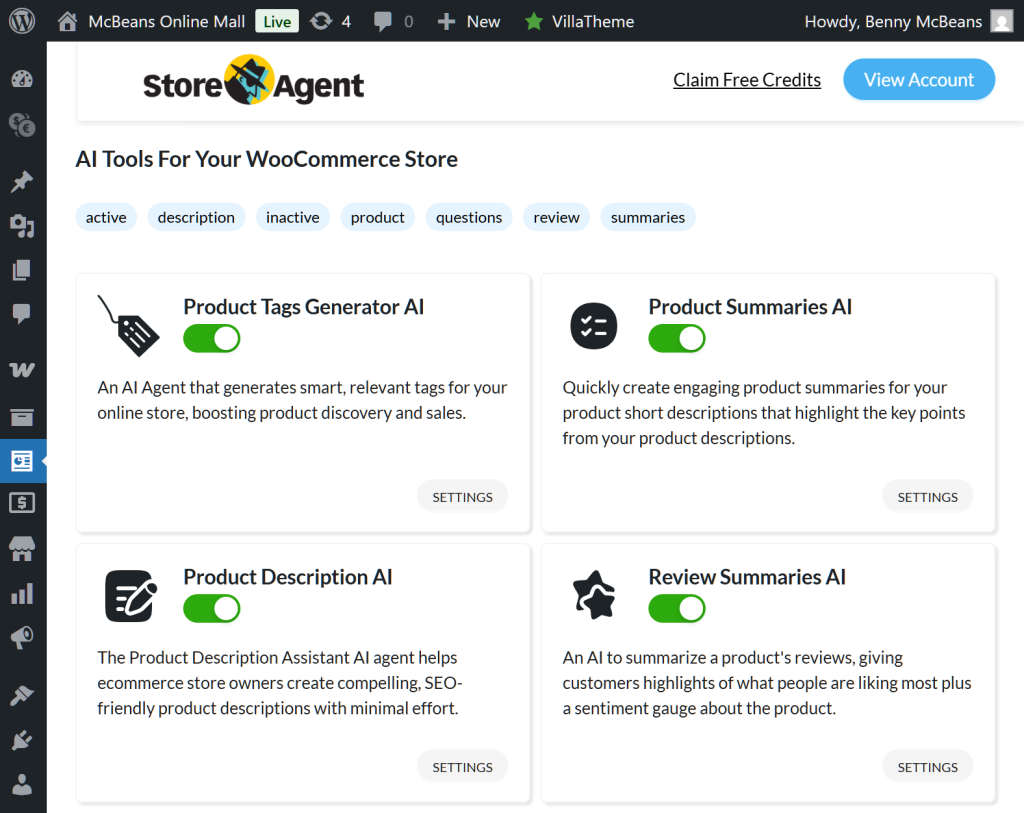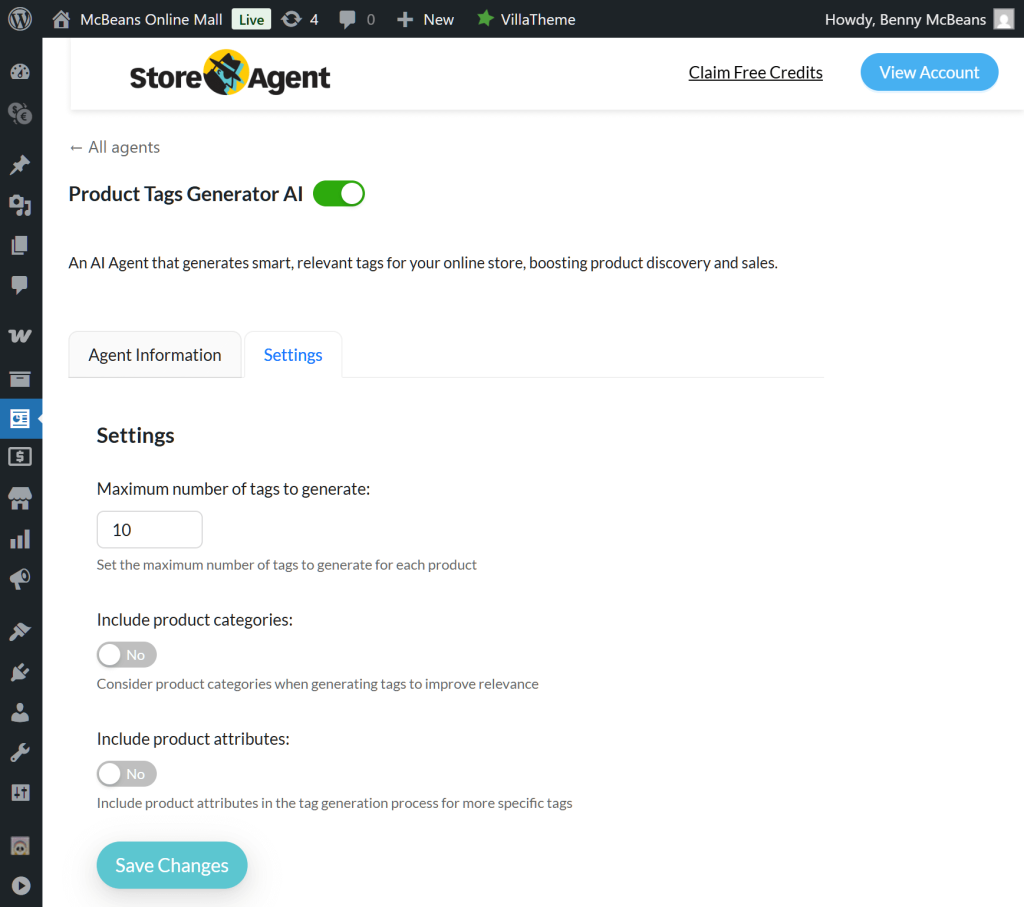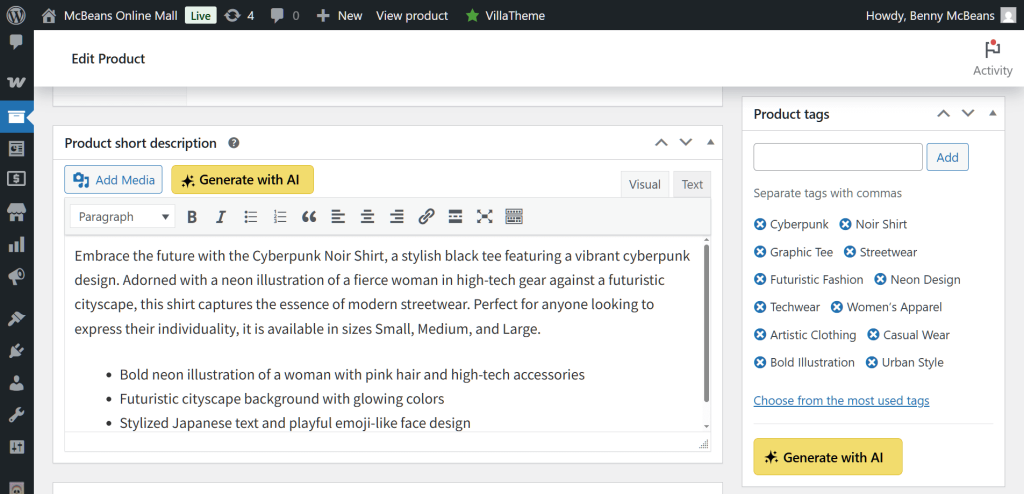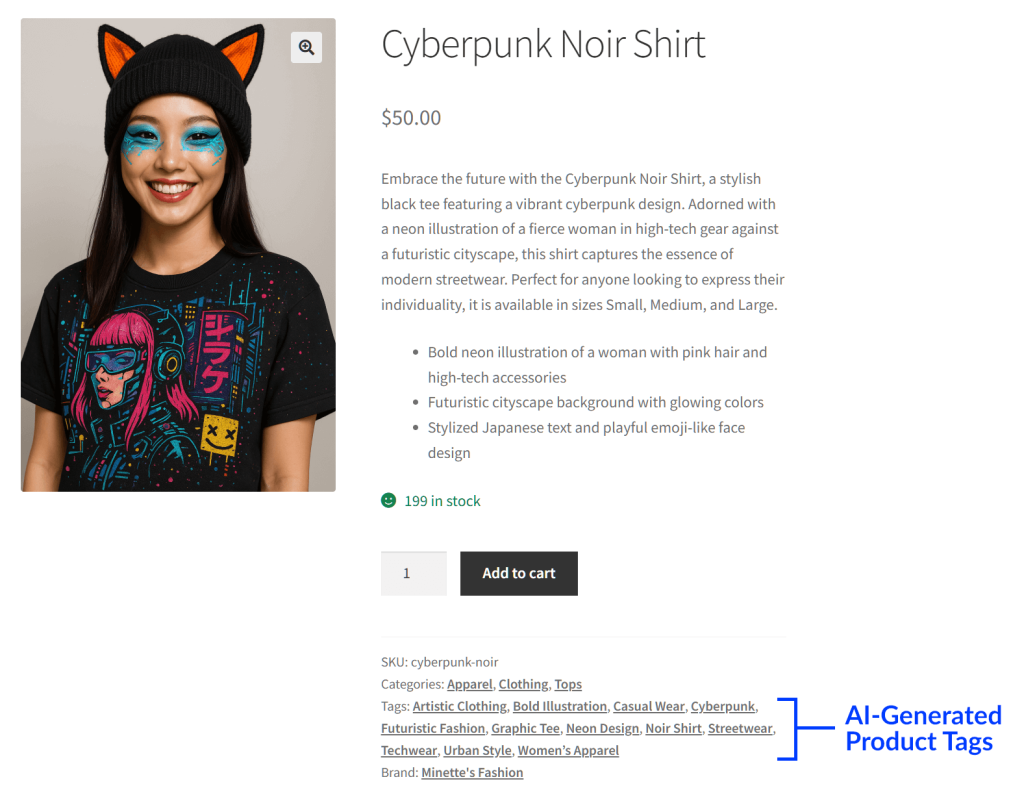
In ecommerce, tags help organize your online store and make products easier to find, guiding shoppers to exactly what they’re looking for. And with an AI-powered product tag generator, you can create the best tags for your products.
That’s not all. We’ve seen firsthand how a good AI product tag generator automatically generates tags, saving you time and effort. After all, you no longer have to tag each item manually, making the process much quicker and easier.
In this article, we’ll explain how product tags work, why they’re important, and how StoreAgent’s Product Tag Generator can help. Furthermore, we’ll show you how to use this WooCommerce AI tool step by step!
So, ready to learn more? Let’s jump right in!
- I. What Is A Product Tag In Ecommerce?
- II. What Is An AI Product Tag Generator?
- III. How StoreAgent’s Product Tag Generator Can Help
- IV. Step-by-Step Guide On Using The StoreAgent Product Tag Generator
- Conclusion
I. What Is A Product Tag In Ecommerce?
In ecommerce, a product tag is a descriptive keyword, attribute, or label added to a product to describe its features, category, or qualities.
Tags help sort products in your store, making them easier to locate. They work like signposts, pointing shoppers to the products they want. Thus, the right tags help your products reach more people, increasing the chances of a sale.
Tags can include color, size, brand, material, seasonality, style, or popular search terms such as “sports equipment” or “holiday gifts.”
Below are some product examples along with the tags you could use for each:
- Stainless Steel Mixer: stainless steel, mixer, kitchen appliance, durable, easy to clean
- Bluetooth Speaker: Bluetooth, speaker, wireless, portable, sound
- Leather Jacket: leather jacket, jacket, fashion, punk style, outerwear
- Blue the Husky Action Figure: Blue the Husky, action figure, collectible, poseable, toy with cannons
- Gold-Plated Chess Set: gold-plated, chess set, luxury, board game, collectible
- Husbando Pillow: husbando, dakimakura, anime body pillow, cuddle pillow, otaku gift

How exactly do product tags work?
There are various ways product tags work:
1. Tags help people find your product
Tags are words that describe your product. In other words, they tell the store what it is, like its color, style, or how it’s used.
When someone searches or uses filters, the store looks at tags to show the right products. For example, a hoodie with tags like “black,” “zip-up,” and “streetwear” will show up when people search for those words.
2. Tags help people see similar items
In most online stores, tags are clickable. When you click a tag, it takes you to a page with other products that have the same tag.
So if you’re looking at a husbando pillow with tags like “anime merch” or “dakimakura,” clicking one of those tags will show you more anime stuff or body pillows. It’s a fast way to explore without searching again.
3. Tags help you group products
Some stores use tags behind the scenes to group items for special sections. For example, you might see a homepage block called “gifts under $20.” Tags help make those sections by linking products with similar themes or prices.
This makes it easier to build collections without doing it all by hand.
4. Tags can help with search engines
If your tag pages show up in Google, people can land on those pages when they search online. For example, someone looking for “cute fox plush” might end up on your tag page if that’s one of your tags.
This brings more people to your store even if they don’t start on your homepage.
5. Tags help you see what’s working
Tags aren’t just for shoppers—they help store owners too. You can track which tags get clicked the most or lead to more sales.
Thus, tags help you learn what styles, features, or themes your customers like best.
We’ve seen how well-organized tags can greatly impact visibility. This is especially true in online stores, where quick product discovery can make or break a sale.
II. What Is An AI Product Tag Generator?
An AI product tag generator is a tool that automatically creates tags for your products. Basically, it uses artificial intelligence to analyze product details and suggest relevant keywords.
Unlike manually tagging each product, which can be time-consuming, an AI tag generator speeds up the process. It looks at your product features, like size, color, or material, and then suggests tags based on that information.
From our experience, using an AI product tag generator can save a lot of time and effort. It removes the guesswork, ensuring the right tags are applied every time. Thus, it makes organizing your store a breeze and helps customers find exactly what they’re looking for faster.
A great example of such a tool is StoreAgent’s Product Tag Generator.
III. How StoreAgent’s Product Tag Generator Can Help
StoreAgent is a collection of AI-powered tools designed to help WooCommerce store owners.
Each AI tool can automatically tackle a specific ecommerce task quickly and accurately. For example, StoreAgent has tools that automatically:
- Summarize customer reviews
- Generate long product descriptions
- Craft concise product summaries
- Answer customer inquiries
One of StoreAgent’s tools is Product Tag Generator.
Product Tag Generator is a powerful tool designed to simplify the tagging process. It automatically generates relevant tags based on your product details, saving you time and effort.
Basically, this AI tool quickly analyzes your product’s features and provides accurate tags, so you don’t have to manually tag every item.
By automating the tagging process, StoreAgent helps store owners focus on other important tasks. It also improves product discoverability and expands your store’s reach. This makes it easier for customers to find what they’re looking for, ultimately boosting sales.
Pro Tip: A product tag generator is a powerful start, but you can automate even more of your content strategy. To learn about other options for tasks like writing descriptions and summaries, check out our full guide on the top-rated AI content tools.
IV. Step-by-Step Guide On Using The StoreAgent Product Tag Generator
In this step-by-step guide, we’ll show you how easy it is to use StoreAgent’s Product Tag Generator.
Simply follow these steps:
Step 1: Access StoreAgent
Head to your WordPress admin dashboard. Then, click StoreAgent AI > AI Agents. This takes you to the StoreAgent page, where you can view all its available AI tools:
Step 2: Set up the Product Tag Generator AI
Next, turn on the Product Tag Generator AI by toggling its button. When the button shows “Active,” the agent is ready to use.
However, it’s a good idea to adjust the tool’s settings first. Thus, click on Settings, then choose the Settings tab to open the Product Summaries AI settings page.
In this section, you can set the maximum number of tags to generate, which is set to 10 by default.
You can also choose to include product categories or attributes in the tags.
When you’re finished, click the Save Changes button.
You can also click the Agent Information tab to get more details about the AI.
Step 3: Let the AI do the work
Now, you can use the AI to generate product tags.
First, go to Products > All Products. Then, select the product you wish to create tags for. For this tutorial, our product will be a t-shirt called “Cyberpunk Noir.”
Once you’re on the product’s Edit product page, look for the Product tags box. Usually, this is located on the right side of the page.
With Product Tag Generator active, you’ll notice a Generate with AI button. Click it, and the AI will generate tags for your product.
Basically, all it takes is a few seconds for the AI to generate tags.
You can click the same button again if you want to add more tags. You can also delete unwanted tags and manually add new ones.
Once you’re done having the AI create tags, click the Update button in the Publish box to save your changes!
The result…
Below is an image showing how the AI-generated tags appear on a live product page as customers see it.
Nice work! With StoreAgent, you’re now all set to create product tags that help more people find your items and explore what your store has to offer.
Conclusion
Thanks to AI, tagging doesn’t have to be a chore anymore.
With a product tag generator like StoreAgent’s, you can speed up a task that used to take ages. It keeps your tags consistent, helps shoppers find what they need faster, and saves you from doing everything manually.
To summarize, this article explored the following major concepts:
- What is a product tag in ecommerce?
- What is an AI product tag generator?
- How StoreAgent’s Product Tag Generator can help
- Step-by-step guide on using the StoreAgent Product Tag Generator
Do you have any questions about product tag generators? Reach out to us and let us know; we’d be happy to hear from you!







